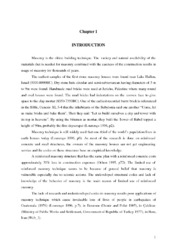Please use this identifier to cite or link to this item:
https://hdl.handle.net/11147/3405Full metadata record
| DC Field | Value | Language |
|---|---|---|
| dc.contributor.advisor | Aktaş, Engin | - |
| dc.contributor.author | Teomete, Egemen | - |
| dc.date.accessioned | 2014-07-22T13:51:28Z | - |
| dc.date.available | 2014-07-22T13:51:28Z | - |
| dc.date.issued | 2004 | - |
| dc.identifier.uri | http://hdl.handle.net/11147/3405 | - |
| dc.description | Thesis (Master)--Izmir Institute of Technology, Civil Engineering, Izmir, 2004 | en_US |
| dc.description | Includes bibliographical references (leaves: 141) | en_US |
| dc.description | Text in English; Abstract: Turkish and English | en_US |
| dc.description | xiii, 144 leaves | en_US |
| dc.description.abstract | Historical structures are our cultural values that left behind by the thousands of year.s cultural accumulation. They pass our identity and civilization to the next generations. Conservation of historical structures and carrying them to the future are our inevitable duty.Before restoration and strengthening, historical structures must be analyzed thoroughly. The problems of the structure should be well identified; taking into account the special conditions of the structure, assessmental applications should be planned and applied. The assessment procedure generally consists of history investigation, measurement survey, material and structural tests, foundation survey, long term observations and structural analyses. Today, finite element analyses is the most common method of structural analyses of historical masonries. In this thesis finite element (FE) modeling of historical masonry structures was investigated. The study has been conducted on a case study, Urla Kamanli Mosque. History investigation, measurement survey, long term observations, material tests have been conducted. The seismicity of the region and local soil conditions were investigated. By using the data collected, FE analyses of the structure was performed by use of LUSAS, a commercial FE software. The structure is safe under its self weight while high tensional stresses occur at the drum-dome connections and at the second level windows and drum windows. The seismic analyses were conducted by use of response spectrum. The empty lintel places and the drum-dome connections are vulnerable under seismic loads. Linear elastic settlement analyses with self weight enlightens the reason of the existing cracks of the structure Nonlinear settlement analysis with self weight was conducted by use of concrete material model of LUSAS. The existing cracks' pattern of the structure was approximately simulated by the 1st principal stress contours. The concrete material model of LUSAS is suitable for analysis of masonry structures. | en_US |
| dc.language.iso | en | en_US |
| dc.publisher | Izmir Institute of Technology | en_US |
| dc.rights | info:eu-repo/semantics/openAccess | en_US |
| dc.subject.lcc | TH5311 .T31 2004 | en |
| dc.subject.lcsh | Masonry--Maintenance and repair | en |
| dc.subject.lcsh | Historic buildings--Conservation and restoration--Turkey--Urla | en |
| dc.subject.lcsh | Historic preservation--Turkey | en |
| dc.title | Finite Element Modeling of Historical Masonry Structures; Case Study: Urla Kamanli Mosque | en_US |
| dc.type | Master Thesis | en_US |
| dc.institutionauthor | Teomete, Egemen | - |
| dc.department | Thesis (Master)--İzmir Institute of Technology, Civil Engineering | en_US |
| dc.relation.publicationcategory | Tez | en_US |
| dc.identifier.wosquality | N/A | - |
| dc.identifier.scopusquality | N/A | - |
| item.languageiso639-1 | en | - |
| item.openairetype | Master Thesis | - |
| item.grantfulltext | open | - |
| item.fulltext | With Fulltext | - |
| item.openairecristype | http://purl.org/coar/resource_type/c_18cf | - |
| item.cerifentitytype | Publications | - |
| Appears in Collections: | Master Degree / Yüksek Lisans Tezleri | |
Files in This Item:
| File | Description | Size | Format | |
|---|---|---|---|---|
| T000494.pdf | MasterThesis | 19.56 MB | Adobe PDF |  View/Open |
CORE Recommender
Page view(s)
468
checked on Jun 10, 2025
Download(s)
316
checked on Jun 10, 2025
Google ScholarTM
Check
Items in GCRIS Repository are protected by copyright, with all rights reserved, unless otherwise indicated.